White Tara long life practice video with special 5-colors protection light guided visualization from Venerable Zasep Rinpoche
Why is White Tara practice and visualization one of the most popular and life-affirming practices in Buddhism? Tara, the Saviour, in her White Tara form, is famous as a health and long-life practice — but is it possible to achieve longevity through meditation? And what about karma?
Zasep Tulku Rinpoche answers these questions and gives a short video teaching on White Tara, a practice known for long-life activities and healing energy. Rinpoche teaches the benefits, then — in great detail — how to visualize White Tara and the healing and protective energy. As he says at the end of the video:
“It’s wonderful. Wonderful protection, wonderful for longevity, good health. And I wish you have longevity and much more happiness.”
Note: If you have initiation, you would visualize as Rinpoche outlines in detail. If you do not have initiation, you can still do the practice and mantra by visualizing White Tara in front of you, facing you, with healing light coming into you — rather than yourself as Tara.
Event Notice: If you are interested in more teachings from Venerable Zasep Rinpoche, on May 1, Rinpoche will offer Prajnaparamita Empowerment via Zoom (by donation.) Details here>>
Full transcript of teaching
H.E. Zasep Rinpoche: I would like to give some instructions and explanation on how to practice White Tara longevity. There are different Tara practices. White Tara practice is for longevity and good health.
Question: Is it possible to achieve longevity? And what about karma? Some people ask the question. Maybe it’s already predetermined, how long one could live once a lifespan. Yes, of course. Everything is karma, but that doesn’t mean we cannot practice long-life practice, and it does not mean that long-life practice does not have effect on us. [Transcript continues after the embedded video below.]
30 minute White Tara healing video
Rinpoche teaches with visualization aids a method of meditating on the five colours, a precious lineage healing teaching. This video, from the Buddha Weekly Guided Meditation Series, plays here [Full transcript below video] :
Karma and long life
Because when you practice long-life sadhana, long-life mantras like White Tara or Amitayus Buddha, and so forth, you are also creating good karma, or long life, this very moment. So, there’s many different karmas; karmas of the past life, karmas of the present life, karmas of now, and future karma, and so forth.

So, I will explain how does it work for practicing long-life mantras and sadhanas. Okay, so when you practice long-life sadhana, such as White Tara, and recite the mantras, it purifies unwholesome karmas of your past life, that you may have unwholesome karma that you’ve created in the past life that makes your life shorter. You may have a number of unwholesome karmas, or maybe one big one, or maybe one little one. You don’t know. We don’t know. But we assume so, because from the reincarnation point of view, that we have no beginning.
We do know people have a short lifespan. And we also know, ourselves, that somehow genetically we may not live very long when you look through your experiences about your grandparents and ancestors and they died from a short life. And so forth. And, today is a very difficult time, and there are so many causes for shortening life. Disease and all kinds of things, as you know, I don’t need to explain to you. So, this is why we practice long-life Buddhas, so it purifies the past life karmas.

Good karma and merit
And also, I’m not only talking about negative karmas of the past life. We have, also, positive karmas. We have virtues and many, many, many lifetimes we have created good karma and virtues and merit. Some of you might think, how do we know that we have created good karma in the past life? Well, we don’t know everything, of course. Human beings don’t know everything, and this is why we call the Buddhas our ‘All-Knowers’ and ‘Omniscient’. So, we don’t know.
But when you look at this life, you have a good life, a fairly wholesome life, and especially you have opportunity to practice dharma. You are already practicing dharma. This means that you have created wonderful, good karma in the past life. So then, you may have many, many good karmas and also good karmas of long life.
So when you practice long-life sadhanas, such as White Tara and mantras, it brings those karmic seeds that you created in the past life, bringing those karmic seeds, bringing the previous life, long-life karmic seeds out, ripening in this life — to ripen in this life.
Because it will be very helpful at this moment, in this life, we have the opportunity to practice dharma. So, why not you make life longer? In other words, extend your life. It’s like you’re getting an extension Visa to extend your life. So, this is why we practice long life, White Tara sadhanas and mantras, and other long-life Buddha practices, such as Amitayus. This is why we do it.

How to — a White Tara visualization
Okay, now, how do we do long-life White Tara practice? Traditionally, you have to receive the initiation of White Tara from a qualified master, qualified guru. And if you don’t have the initiation, you can also ask for mantra transmission from the Lama. And we call Lung, a Tibetan word. Lung means transition, and you can get that from Lama. And if you don’t have the lung, you can still practice and say the mantra, there’s no problem because with good intention, with devotion, you can say the mantra anytime and anyplace.

So, now, let’s say those of you who have received White Tara initiation, then you visualize yourself as White Tara. And you’re sitting on the lotus and moon cushion. So, you say the Sanskrit mantra
OM SVABHAVA SHUDDHA SARVA DHARMA SVABHAVA SHUDDHO HAM.
Everything becomes empty in inherent existence, and from the state of emptiness, I arise myself as the White Tara. I generate myself, visualize myself as a venerable, holy White Tara. So, when you say OM SVABHAVA SHUDDHA SARVA DHARMA SVABHAVA SHUDDHO HAM, imagine your ordinary body and ordinary perceptions and ordinary mind dissolve into śūnyatā, emptiness.
EDITORS NOTE: For those without initiation/empowerment, you simply visualize White Tara in front of you, facing you, with her healing light coming into you.
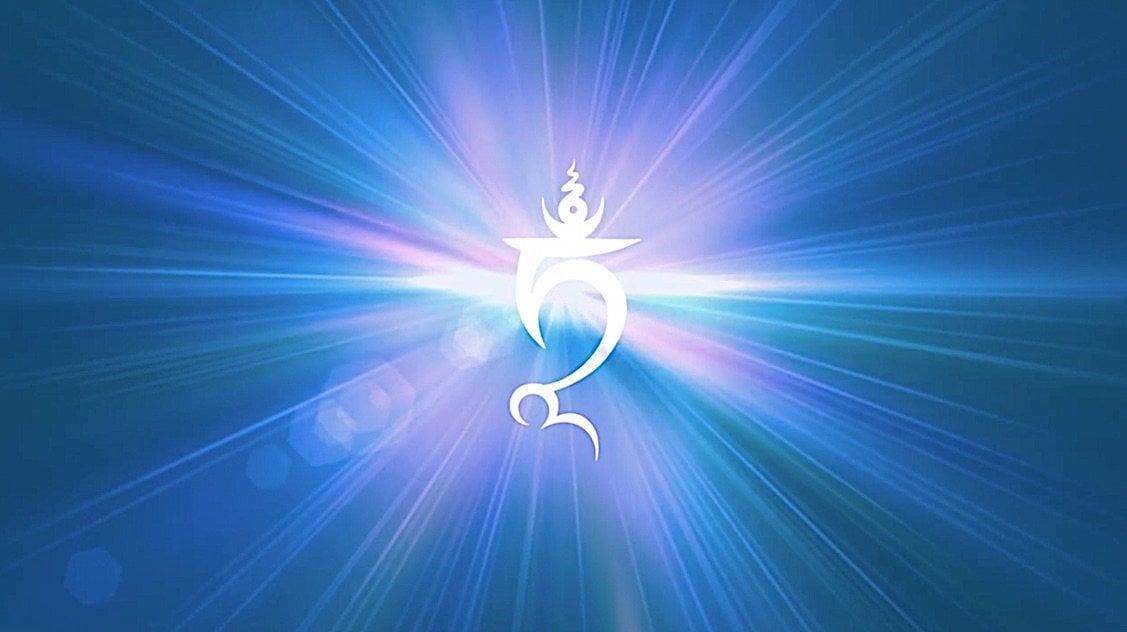
White Tam Syllable
And from the state of voidness [emptiness], you appear yourself as the White Tara. First, you visualize a lotus moon cushion, and then little of the moon cushion you visualize the white TAM syllable. T-A-M, TAM syllable, in English. If you don’t know the Tibetan syllable, then you visualize the English syllable, white TAM. And if you know the Tibetan one, syllable, then you visualize Tibetan syllable, TAM. That will be good. And you can also learn, and you can learn the Tibetan letter alphabet.
So visualize white TAM syllable, standing on the moon disc. When you visualize the syllable, imagine the syllable is in the nature of light and transparent, and beautiful white TAM syllable.
Then, white light shining. White light shining, white light goes out all in directions, ten directions. And especially white light goes to Buddha realms, pure lands of the Buddhas. And this white light bringing the blessings of all the Buddhas.
Also, especially, blessings of White Tara in the form of white lights descending. Lots of white lights descending from all directions, dissolve into the white TAM syllable.

White Tara visualization in detail
After that, the white TAM syllable getting bigger and bigger, and slowly bigger. And then slowly merging myself into White Tara. So, I, myself becomes White Tara. And imagine I am sitting on the lotus and moon cushion, I’m white color — white color is color of peace, the color of purity. So I have one face, two hands. At this time I am sitting cross-legged Vajra Asana. White Tara sits cross-legged. This is different from Green Tara’s posture.
I — as White Tara — wear beautiful silk dresses and jewel ornaments, earrings, necklaces, and bracelets, and so forth. Crown ornaments. I have an ushnisha above my head. I have long hair with top-knot, and the rest of the hair loose and hanging behind my body. I am holding a blue uptala flower in my left hand. And sometimes you visualize lotus flower, so either way is fine. Uptala flower or lotus flower is an alternative, or optional.
So, my left hand is in the mudra of representing Buddhas of the three times; Buddhas of the past, present, and future. That means I, myself, as White Tara, am the embodiment of the Buddhas of the past, present, and future.
My right hand is in the mudra of giving blessing, giving realizations, or helping you to have spiritual realizations. Also, White Tara has seven eyes. One eye on the forehead, wisdom eye, so that makes three eyes, then one eye in each palm of the hand, and then also eyes at the bottom of her feet. So altogether, seven eyes.
Mantra visualized at your heart
So now, I visualize myself as White Tara. Once you visualize yourself as White Tara, then you visualize a moon disc at your heart, horizontal. Then at the top of the moon disc, in the middle of the moon disc, you visualize white TAM syllable, seed syllable. And this time the seed syllable is surrounded by the mantra of White Tara.

So, White Tara mantra is a little different from Green Tara mantra. You visualize Om Tare Tuttare Ture Mama Ayu Punye Jnana Pushtim Kuru Soha. That’s the mantra. So, longer. Extra mantra. You add Mama Ayu Punye Jnana Pushtim Kuru Soha [to the root mantra Om Tare Tuttare Ture.]
Om Tare Tuttare Ture Soha means liberating myself from this world and from suffering and disease and so forth. Om Tare Tuttare is liberating from the cause of suffering; karma and delusions. And Om Tare Tuttare Ture Soha means liberating myself completely from this life, the cycle of lives, from Samsara, to reach enlightenment; Om Tare Tuttare Ture.
Then you say Mama Ayu Punye Jnana Pushtim Kuru Soha. This means, increasing wisdom, virtues. Mama Ayu is increasing long life. Punye is virtues. Jnana is wisdom. Punye Jnana Pushtim Kuru Soha. Punye karma, and good karma and virtues. So, increase your long life, virtues, and wisdom. Punye Jnana Pushtim Kuru Soha. To achieve long life siddhi. So, visualize the White Tara mantra at your heart, then light shining from your heart. And then you say White Tara mantra; repeat White Tara mantra.
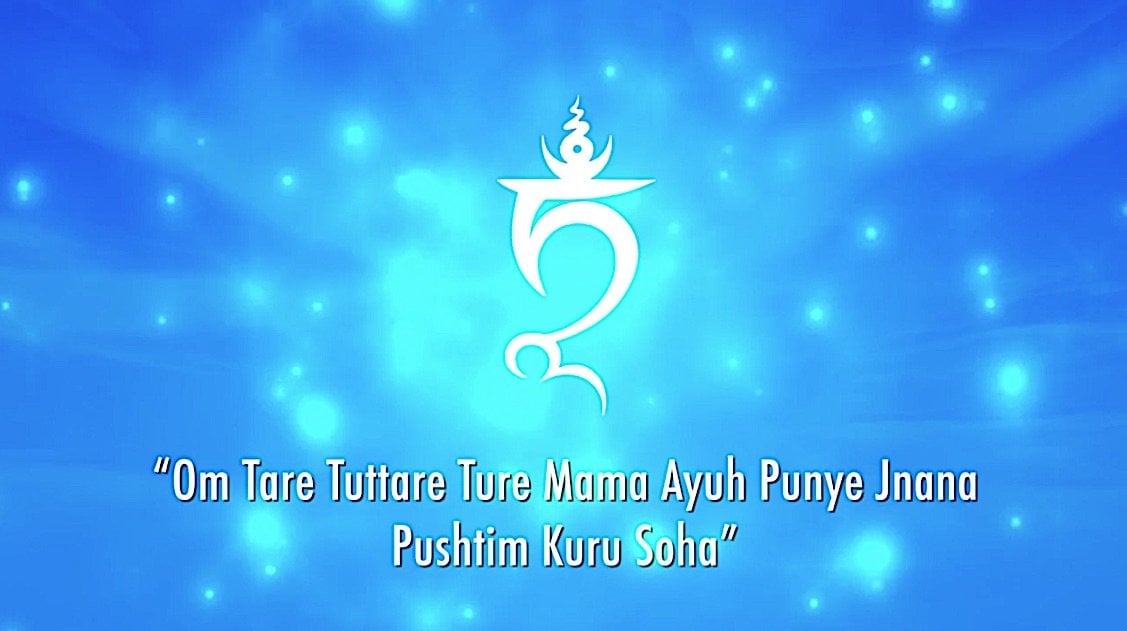
Healing white light fills your body
While you’re repeating the white Tara mantra, imagine white light shining from your heart, from those syllables. And the light goes inside your body through the top of your head to the bottom of your feet. Your entire body is filled with white light. Also, your mind, your consciousness, is filled with the light of longevity and good health. Your senses filled with white light of longevity. Your sense consciousness filled with white light of longevity.
Your sense consciousness, primary mind, sixth sense consciousness, they are what we call primary mind. Eye consciousness, ear-consciousness, nose-consciousness, tongue-consciousness, body-consciousness, and tactile-consciousness, and the main-consciousness. All of them, purified.
Within this consciousness and the body, if there are any kind of stains, or suffering, or pain, or trauma, or defilement, and subtle disease, subtle defilement, cause of disease, whatever, karmic imprints, all of them are purified. Completely purified. No more. And you achieve long life siddhi. Sanskrit word siddhi means realizations, and powerful realizations. Siddhi.
Benefits of the visualization
Now, I will explain a little bit more about the benefits of visualization at this time. Protection. Protection for your life force. So, we have life. We are alive right now. And because our consciousness is based in your heart chakra — from the tantric Buddhist point of view, the heart chakra.
Your consciousness is supported by prana (Sanskrit for “breath”) called life-sustaining prana. So, this prana is important prana. It’s very, very, very subtle prana. And this is the most subtlest prana, and it’s called indestructible prana. Life-sustaining prana depends on your karma in this life. So when your karma is exhausting and diminishing, then your life-sustaining prana becomes weak.
When the prana of life-sustaining becomes weak, then your consciousness becomes weak. Of course, your body becomes weak, everything becomes weak. Then, gradually, life force is diminishing. Then it makes the life getting shorter, shorter, shrinking, shrinking the life force. This is why people have short life.

White Tara purifies unwholesome karmas
So, when you do the long-life Tara mantra and breathing meditation, visualization, it purifies unwholesome karmas; it creates virtuous karma. Then your life-sustaining prana becomes stronger, powerful. So it’s like in the oriental philosophy, they talk about chi, inner chi. Same thing.
So, your prana becomes stronger and then your consciousness can remain on this life-sustaining prana comfortably and happily. You feel that you want to stay, you are optimistic, and this is how you achieve long life siddhi. [Siddhi is Sanskrit for “attainment”]
And also, you get inspiration in your mind. Positive mind. You get a positive imprint. That’s very important. Uplifting, healing. Then you feel, I have purpose, reason to live. I’m not just sitting here waiting, an old man or old lady. I have a purpose to live. So this is why people can live long, and not only live long, but with good health and with good energy.
My 100-year old teacher
One of my spiritual mentors, he was Mongolian lama, he lived 100 [years] and one month. I’m told the last day of his life, his mind is absolutely sure, clear. And he’d did so much spiritual work, healing, and community service, and rebuilding Buddhism in Mongolia. His name was Guru Dewa Rinpoche. Everybody knows Guru Dewa Rinpoche, and many Tibetan people in India know him very well. So, I believe that he had a long-life siddhi.
White Tara 5 Colours Protection: Special Practice
So, now, I’m going to give you a short explanation on how to do the protection. So then, you focus your meditation on your heart at the white TAM syllable.
White Light around you
Now, imagine your white light shining from your heart — it goes outside your body: this time it goes all the way around like a tent. Like a yurt. So, these are white lights, totally, completely solid. The white light symbolizes peace, siddhi of peace. So then you imagine your body-mind is all protected.
And you say
Om Tare Tuttare Ture Mama Ayu Punye Jnana Pushtim Kuru Soha.
Yellow light outside white light
Then, outside that white light you visualize another light. This time, yellow light. Again, yellow light emanating from your heart, from the TAM syllable, goes outside the white light. Another layer of yellow light, like a tent outside a tent. White light is the symbol of peace. Yellow light is a symbol of longevity and prosperity. These lights are very solid. Strong. Nothing can enter, no negative forces.
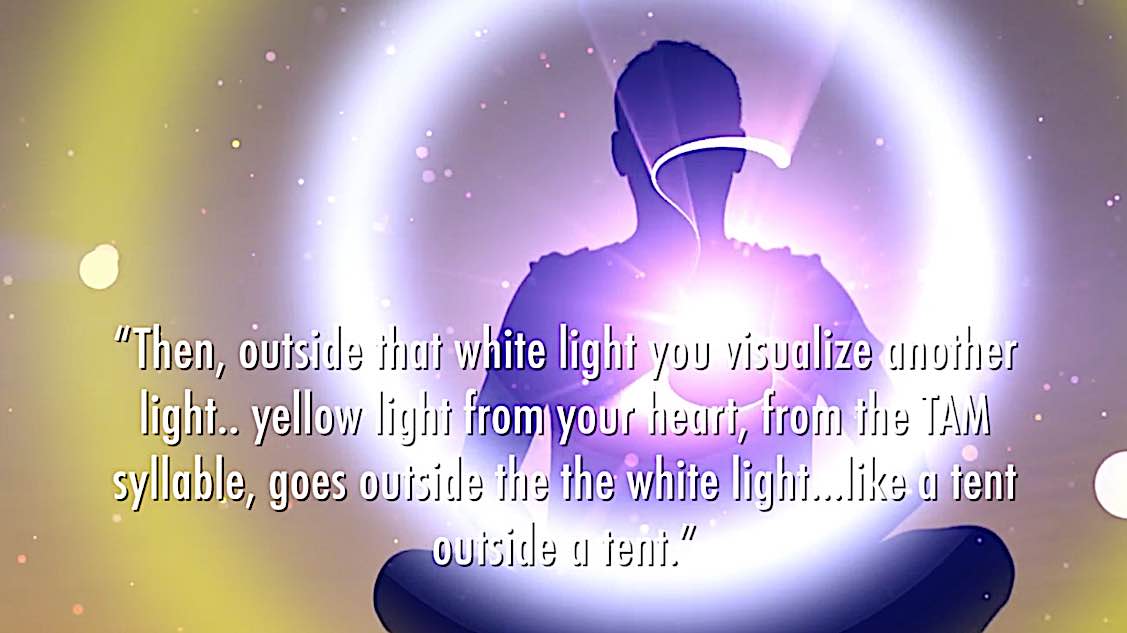
Red light outside yellow light
Now, between … Okay, I’ll explain that later. Then, after the yellow light, again, red light shining from your heart, from the TAM syllable, goes out in a layer of red light like a tent. And the red light is a symbol of power. You have long life; power.
Blue light outside red light
And then, you visualize blue light. Blue light shines from your heart from the TAM syllable, goes out and outside the red light. Very strong, round, solid, and gives you energy and power.
Green light outside blue light
Then, the last one, you imagine green light shining from the TAM syllable, goes straight outside the blue light. So, the green light is what we call the light of action.
Five colors of protection
So, five colors of light: white, yellow, red, blue, and green. These all symbolize peace, knowledge, prosperity, power, and blue is energy (symbolizes energy and healing), and the green one symbolizes action, activity — like a green color is action and like a green grass, green forest, when spring comes and the leaves are changed, the color becomes green. Like that, action color.
So you have five kinds of what we call siddhi, in Sanskrit, peaceful siddhi. Siddhi of knowledge and wisdom, siddhi of power, siddhi of energy, siddhi of action (karma). Sanskrit word is Sita, Ratna, Padma, Vajra, and action [Karma].
- The white color represents Sita, siddhi of peace.
- The yellow color symbolizes Ratna siddhi.
- The red color symbolizes Padma siddhi.
- The blue color symbolizes Vajra siddhi.
- And green light symbolizes Karma siddhi.
I studied Sanskrit, myself, in Sanskrit University; Sanskrit in India, so I know a little bit about Sanskrit. It is very helpful to know Sanskrit.
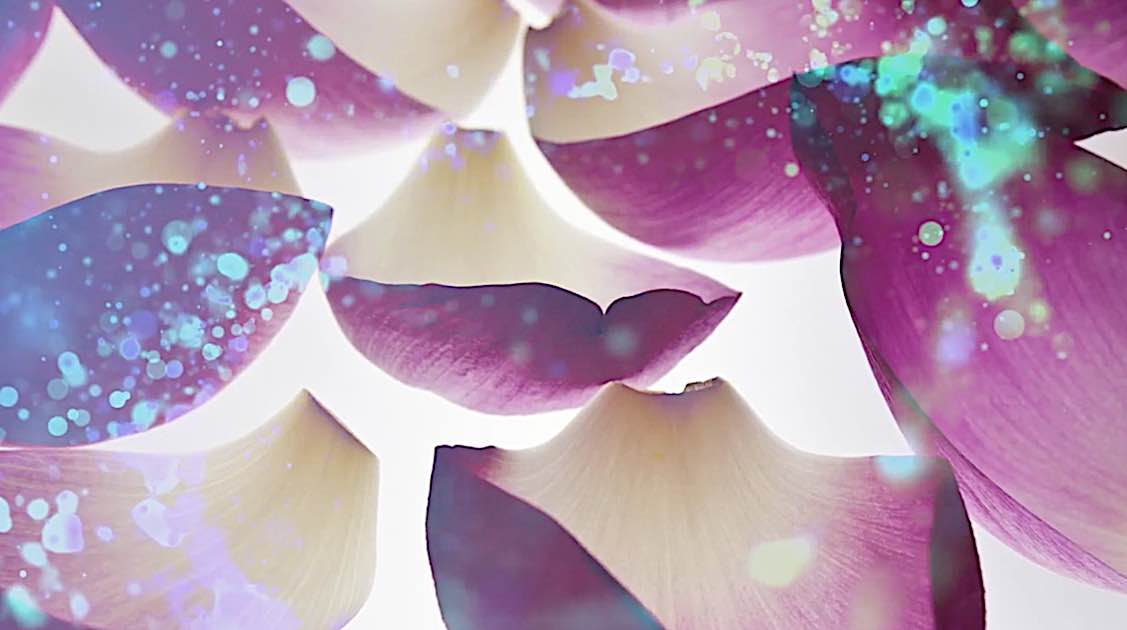
The layer of purple lotus petals
You imagine now you have all the siddhis around and you are protected. On top of that, one last thing, between these layers of lights you visualize purple color, lotus petals. Purple color of lotus petals filled between all the layers of colors.
Then you say the mantra
Om Tare Tuttare Ture Mama Ayu Punye Jnana Pushtim Kuru Soha.
It’s wonderful. Wonderful protection, wonderful for longevity, good health. And I wish you have longevity and much more happiness. Thank you very much.
About Venerable Zasep Rinpoche
Venerable Acharya Zasep Tulku Rinpoche is Spiritual Director of Gaden for the West, with meditation centers in Canada, Australia and the United States. Rinpoche is popularly known for his approachable teaching style, strong humor and teachings based on a long lineage of great lamas. His own gurus included the most celebrated of Gelug teachers: His Holiness Kyabje Trijang Rinpoche, His Holiness Kyabje Ling Rinpoche, Venerable Geshe Thupten Wanggyel, His Holiness Kyabje Zong Rinpoche, Venerable Lati Rinpoche, Venerable Tara Tulku Rinpoche and Venerable Khalkha Jetsun Dampa Rinpoche. Rinpoche is spiritual director of many temples, meditation centres and retreat centres in Australia, the United States and Canada. He was first invited to teach in Australia by Lama Thubten Yeshe in 1976.
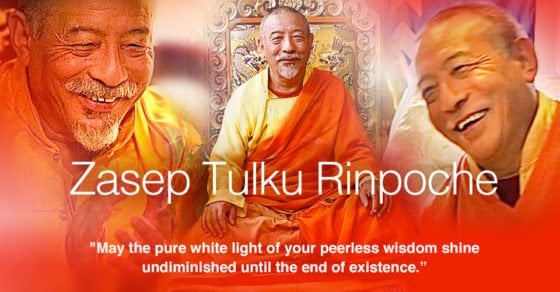
Venerable Zasep Tulku Rinpoche with a line from his “long life prayer” which was composed by his teacher HH Kyabje Trijang Rinpoche.
2 thoughts on “White Tara long life practice video with special 5-colors protection light guided visualization from Venerable Zasep Rinpoche”
Leave a Comment
More articles by this author
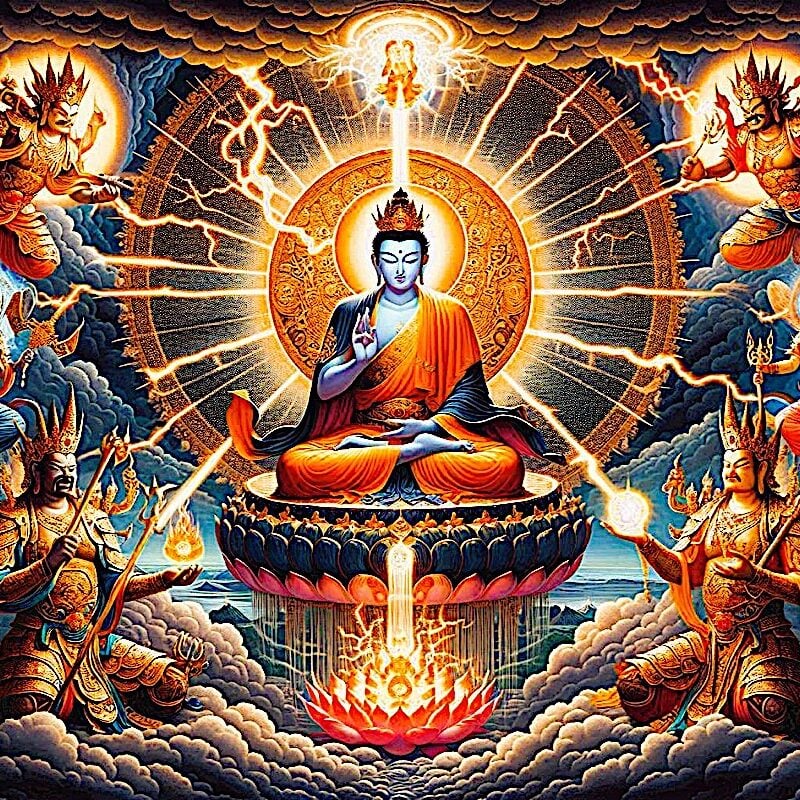
Protection from all Harm, Natural Disaster, Weather, Spirits, Evil, Ghosts, Demons, Obstacles: Golden Light Sutra: Chapter 14

Guru Rinpoche is ready to answer and grant wishes: “Repeat this prayer continuously” for the granting of wishes

VIDEO: Vajrapani Vajra Armor Mantra: Supreme Protection of Dorje Godrab Vajrakavaca from Padmasambhava
Search
Latest Features
Please support the "Spread the Dharma" mission as one of our heroic Dharma Supporting Members, or with a one-time donation.
Please Help Support the “Spread the Dharma” Mission!

Be a part of the noble mission as a supporting member or a patron, or a volunteer contributor of content.
The power of Dharma to help sentient beings, in part, lies in ensuring access to Buddha’s precious Dharma — the mission of Buddha Weekly. We can’t do it without you!
A non-profit association since 2007, Buddha Weekly published many feature articles, videos, and, podcasts. Please consider supporting the mission to preserve and “Spread the Dharma." Your support as either a patron or a supporting member helps defray the high costs of producing quality Dharma content. Thank you! Learn more here, or become one of our super karma heroes on Patreon.
Lee Kane
Author | Buddha Weekly
Lee Kane is the editor of Buddha Weekly, since 2007. His main focuses as a writer are mindfulness techniques, meditation, Dharma and Sutra commentaries, Buddhist practices, international perspectives and traditions, Vajrayana, Mahayana, Zen. He also covers various events.
Lee also contributes as a writer to various other online magazines and blogs.






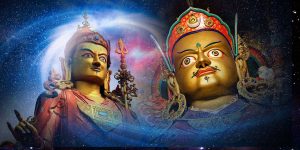

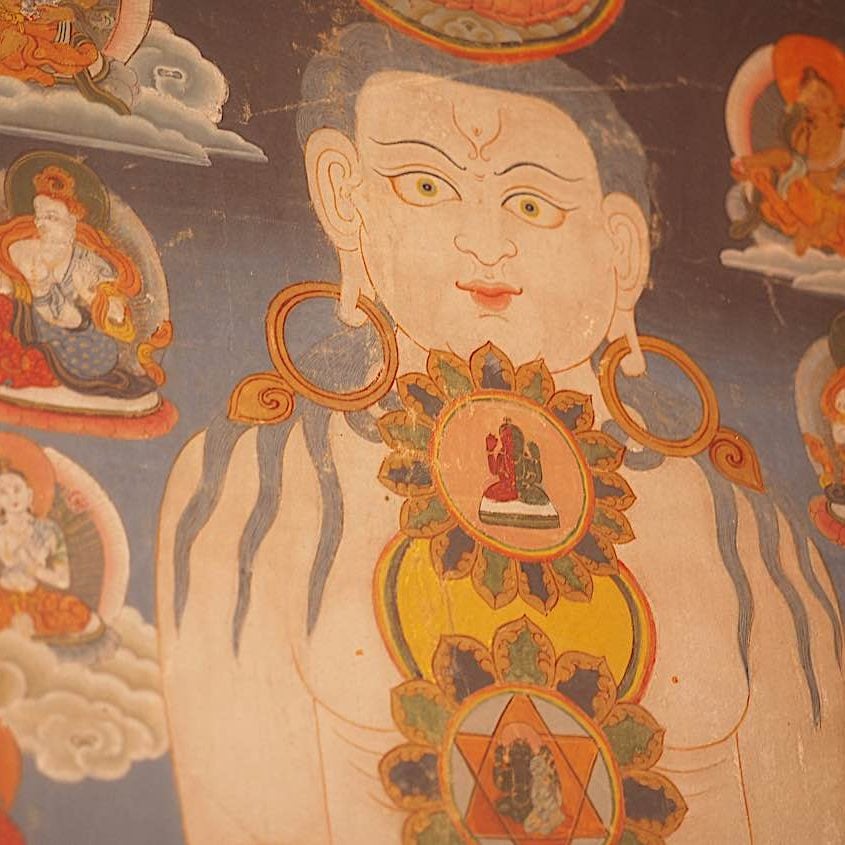







Merci infiniment
Thank you so much for these deep and clear explanation.
May all sentient beings benefit,
~JB
Thank you for your kind words!